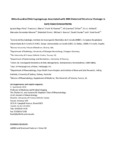Mostrar o rexistro simple do ítem
Mitochondrial DNA haplogroups associated with MRI-detected structural damage in early knee osteoarthritis
| dc.contributor.author | Rego-Pérez, Ignacio | |
| dc.contributor.author | Blanco García, Francisco J | |
| dc.contributor.author | Roemer, Frank W. | |
| dc.contributor.author | Guermazi, Ali | |
| dc.contributor.author | Ran, Di | |
| dc.contributor.author | Ashbeck, Erin L. | |
| dc.contributor.author | Fernández Moreno, Mercedes | |
| dc.contributor.author | Oreiro, Natividad | |
| dc.contributor.author | Hannon, Michael J. | |
| dc.contributor.author | Hunter, David J. | |
| dc.contributor.author | Kwoh, Kent | |
| dc.date.accessioned | 2020-09-16T10:21:50Z | |
| dc.date.available | 2020-09-16T10:21:50Z | |
| dc.date.issued | 2018-07-20 | |
| dc.identifier.citation | Rego-Pérez I, Blanco FJ, Roemer FW, Guermazi A, Ran D, Ashbeck EL, et al. Mitochondrial DNA haplogroups associated with MRI-detected structural damage in early knee osteoarthritis. Osteoarthritis cartilage. 2018;26(11):1562-1569 | es_ES |
| dc.identifier.issn | 1063-4584 | |
| dc.identifier.uri | http://hdl.handle.net/2183/26191 | |
| dc.description.abstract | [Abstract] Objective: Magnetic resonance imaging (MRI)-detected structural features are associated with increased risk of radiographic osteoarthritis (ROA). Specific mitochondrial DNA (mtDNA) haplogroups have been associated with incident ROA. Our objective was to compare the presence of MRI-detected structural features across mtDNA haplogroups among knees that developed incident ROA. Design: Knees from the Osteoarthritis Initiative (OAI) that developed incident ROA during 48 months follow-up were identified from Caucasian participants. mtDNA haplogroups were assigned based on a single base extension assay. MRIs were obtained annually between baseline and 4-year follow-up and scored using the MRI Osteoarthritis Knee Score (MOAKS). The association between mtDNA haplogroups and MRI-detected structural features was estimated using log-binomial regression. Participants who carried haplogroup H served as the reference group. Results: The sample included 255 participants contributing 277 knees that developed ROA. Haplogroups included H (116, 45%), J (17, 7%), T (26, 10%), Uk (61, 24%), and the remaining less common haplogroups ("others") (35, 14%). Knees of participants with haplogroup J had significantly lower risk of medium/large bone marrow lesions (BMLs) in the medial compartment [3.2%, relative risks (RR) = 0.17; 95%CI: 0.05, 0.64; P = 0.009] compared to knees of participants who carried haplogroup H [16.3%], as did knees from participants within the "others" group [2.8%, RR = 0.20; 95%CI: 0.08, 0.55; P = 0.002], over the 4 year follow-up period. Conclusions: mtDNA haplogroup J was associated with lower risk of BMLs in the medial compartment among knees that developed ROA. Our results offer a potential hypothesis to explain the mechanism underlying the previously reported protective association between haplogroup J and ROA. | es_ES |
| dc.description.sponsorship | National Institute of Health; NIH HHSN2682010000 21C | es_ES |
| dc.description.sponsorship | National Institute of Health; NIH AR066601 | es_ES |
| dc.language.iso | eng | es_ES |
| dc.publisher | Elsevier | es_ES |
| dc.relation.uri | https://doi.org/10.1016/j.joca.2018.06.016 | es_ES |
| dc.rights | Atribución-NoComercial-SinDerivadas 4.0 España | es_ES |
| dc.rights.uri | http://creativecommons.org/licenses/by-nc-nd/4.0/es/ | * |
| dc.subject | Bone marrow lesions | es_ES |
| dc.subject | Halogroups | es_ES |
| dc.subject | Knee osteoarthritis | es_ES |
| dc.subject | MRI | es_ES |
| dc.subject | Meniscus | es_ES |
| dc.subject | Mitochondrial DNA | es_ES |
| dc.title | Mitochondrial DNA haplogroups associated with MRI-detected structural damage in early knee osteoarthritis | es_ES |
| dc.type | info:eu-repo/semantics/article | es_ES |
| dc.rights.access | info:eu-repo/semantics/openAccess | es_ES |
| UDC.journalTitle | Osteoarthritis and Cartilage | es_ES |
| UDC.volume | 26 | es_ES |
| UDC.issue | 11 | es_ES |
| UDC.startPage | 1562 | es_ES |
| UDC.endPage | 1569 | es_ES |
Ficheiros no ítem
Este ítem aparece na(s) seguinte(s) colección(s)
-
INIBIC- REUMA - Artigos [184]






